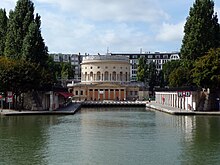Bassin de la Villette
The Bassin de la Villette is the largest artificial body of water in Paris . Formerly a hub for inland shipping , it is now a local recreation area in the 19th arrondissement .
history
Construction under Napoleon Bonaparte

With the aim of improving the city's drinking water supply, Napoleon Bonaparte proclaimed the following law on May 28, 1802:
«The ouvert and canal de dérivation de la rivière d'Ourcq; elle sera amenée à Paris, à un bassin près de la Villette. [...] » (A canal is opened that branches off water from the Ourcq river and brings it to Paris, into a basin at La Villette .)
The architect Pierre-Simon Girard was commissioned with the construction of the 700 by 70 meter and two meter deep basin and its connection to the Canal de l'Ourcq . He designed the basin as the bisector of the two trade routes Route de Flandre and Route d'Allemagne (today Avenue de Flandre and Avenue Jean-Jaurès ) and aligned it exactly with the axis of the Rotonde de la Villette customs post, which was built in 1788 .
After three years of construction (1805 to 1808), the basin was inaugurated on December 2nd, 1808 and was soon considered the little Venice of Paris . Its banks, soon adorned with avenues, became a favorite place for Parisians to stroll. In the then still rural area there were soon a few restaurants and guinguettes . There were jousting . In cold winters, people went ice-skating, and the ladies drove toboggans in the pool.
During the industrial revolution
In the course of the expansion of the Paris waterways and in particular the construction of the Canal Saint-Martin in 1825, the economic importance increased. In 1838 about ten thousand ships called the basin .
| year | 1839 | 1880 | 1900 | 1966 | 1974 |
|---|---|---|---|---|---|
| Handling in tons | 400,000 | 1,300,000 | 2,000,000 | 250,000 | 71,000 |
Handling of goods in the Bassin de la Vilette
Until 1860 the Bassin de la Villette was at the gates of Paris. Here goods could be deleted outside the city limits without paying excise duties . Due to this favorable tax situation, trading companies quickly settled there, including the company der Magasins Généraux , which built large warehouses, a slaughterhouse and a cattle market. For the World Exhibition in 1878, two more steel warehouses were added and gave the La Villette district the reputation of the “warehouse of Paris”.
Between 1880 and 1883 the pool was deepened and enlarged to 3.2 meters. A second, approximately 600-meter-long extension pool between the Rue de Crimée and the rond-point des Canaux at today's Parc de la Villette was built. This also required a new bridge. The swing bridge in the Rue de Crimée was replaced in 1885 by a lift bridge , the Pont levant de la rue de Crimée . It is the last of its kind in Paris today.
Deindustrialization in the 20th century
Since the 1950s, with de-industrialization, the warehouses were increasingly abandoned and fell into disrepair. In 1973 the cattle market closed. In 1988 an urban development program with a volume of more than 100 million euros began, which was intended to upgrade the district . Among other things, social housing, offices, artist studios, two bank promenades and two multiplex cinemas built in old warehouses were built. One of the Généraux magazines that burned down in 1990 was converted into a youth hostel and hotel and the Place de la Bataille de Stalingrad in front of the rotunda was redesigned. The urban development program ended in 2010.
Culture and leisure activities
Today, there are numerous former barges in the Bassin de la Vilette , which have been converted into event locations and cafes. Including the Péniche Opéra with music theater and the children's ship Péniche Antipode . A small ferry connects the eastern Quai de la Loire with the Quai de la Seine . The MK2 cinemas on both sides of the basin are operated by the filmmaker Marin Karmitz . The Bassin de la Villette has been part of Paris-Plages since 2007 .
A swimming pool was opened in the basin in July 2017.
Individual evidence
- ^ France. Sénat, France. Chambre des députés, France. Assemblée nationale (1871–1942): Archives parlementaires de 1787 à 1860, volumes 2–3 p. 693.
- ↑ Potier, Baptiste: La rotonde de la Villette, histoire d'un catalyseur urbain. Paris, 2011. p. 53.
- ↑ Potier, Baptiste: La rotonde de la Villette, histoire d'un catalyseur urbain. Paris, 2011. pp. 55f.
- ↑ - ( Memento of the original from July 6, 2011 in the Internet Archive ) Info: The archive link was automatically inserted and not yet checked. Please check the original and archive link according to the instructions and then remove this notice.
- ↑ http://parisavant.com/index.php?showimage=433
- ↑ http://www.tourisme93.com/document.php?pagendx=1006
- ↑ Association AFLO au fil de l'Ourcq (accessed January 19, 2012)
- ↑ Archive link ( Memento of the original from March 3, 2011 in the Internet Archive ) Info: The archive link was inserted automatically and has not yet been checked. Please check the original and archive link according to the instructions and then remove this notice.
- ↑ http://www.neues-paris-ile-de-france.de/ihr-guide-paris/rundgange/la-villette-und- Umgebung/ein-ort-fur-jedes-alter- 77521.html ( page no longer available , search in web archives ) Info: The link was automatically marked as defective. Please check the link according to the instructions and then remove this notice.
- ↑ [1]
Web links
Coordinates: 48 ° 53 ′ 10 " N , 2 ° 22 ′ 30" E


